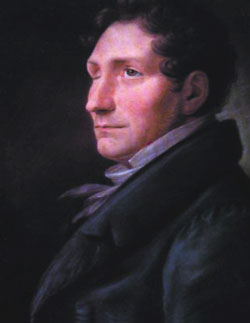Friedrich Kuhlau
| Born | September 11, 1786
Uelzen, Electorate of Brunswick-Lüneburg |
|---|---|
| Died | March 12, 1832 (at age 45) Lyngby, Denmark |
| Main Activity | Composer |
See More :

Friedrich Kuhlau (1786-1832) was born in Hanover, Germany. At age ten he lost his right eye in a street accident. In 1802 his rather poor family moved to Hamburg, where Friedrich received his first serious musical tuition. When Hamburg was invaded by Napoleon´s troops in 1810 Kuhlau fled to Copenhagen, where he was soon recognised as a brilliant pianist. In 1813 he became a Danish citizen and was appointed court chamber musician, though he received no salary for this first position until five years later. Kuhlau also became known as a composer of music dramas. He enjoyed an enormous success with his fairy tale opera Lulu, and the greatest triumph of his career, the incidental music to Heiberg´s Romantic national play The Elf Hill in 1828. He went on concert tours as a pianist in Scandinavia, Germany and Austria. In 1825 he met Beethoven in Vienna, exchanging impromptu canons with him. Kuhlau´s last years were clouded by financial problems, illness, excessive drinking and the deaths of both of his parents, who had lived with him from 1814. As a result of a fire that swept his house in 1831 he suffered a chest ailment from which he never recovered. Kuhlau´s works, more than half of which are for piano solo or piano duet, reveal the influence both of the Viennese Classical composers and of the virtuoso piano writing of Clementi, Dussek, Cramer, Hummel and Weber.
His numerous compositions for flute gave him the nickname “the Beethoven of the flute”. His other chamber music include sonatas for violin and piano, three piano quartets and his final composition and chamber masterpiece, the String Quartet in A minor. An interesting feature in Kuhlau´s music is his parody technique, in which themes and passages by other composers function as a catalyst for his own compositions. Nevertheless, Kuhlau also had his own distinct artistic voice, and his best works exerted a profound influence on later Danish composers.
| Title | Key | Year | Level | |
|---|---|---|---|---|
All pieces: |
||||
Sonatinas |
||||
| Sonatina Op. 20 No. 1 | C Major | 1819 | 5 | |
| Sonatina Op. 20 No. 2 | G Major | 1819 | 5 | |
| Sonatina Op. 20 No. 3 | F Major | 1819 | 6 | |
| Sonatina Op. 55 No. 1 | C Major | 1823 | 4 | |
| Sonatina Op. 55 No. 2 | G Major | 1823 | 5 | |
| Sonatina Op. 55 No. 3 | C Major | 1823 | 5 | |
| Sonatina Op. 55 No. 4 | F Major | 1823 | 4 | |
| Sonatina Op. 55 No. 5 | D Major | 1823 | 5 | |
| Sonatina Op. 55 No. 6 | C Major | 1823 | 5 | |
| Sonatina Op. 59 No. 1 | A Major | 1824 | 5 | |
| Sonatina Op. 59 No. 2 | F Major | 1824 | 5 | |
| Sonatina Op. 59 No. 3 | C Major | 1824 | 5 | |
| Sonatina Op. 60 No. 1 | F Major | 1824 | 7 | |
| Sonatina Op. 60 No. 2 | A Major | 1824 | 7 | |
| Sonatina Op. 60 No. 3 | C Major | 1824 | 7 | |
| Sonatina Op. 88 No. 1 | C Major | 1827 | 6 | |
| Sonatina Op. 88 No. 2 | G Major | 1827 | 6 | |
| Sonatina Op. 88 No. 3 | A Minor | 1827 | 6 | |
| Sonatina Op. 88 No. 4 | F Major | 1827 | 6 | |
Miscellaneous pieces |
||||
| Rondo on a theme from Don Giovanni Op. 31 No. 1 | C Major | – | 4 | |



Leave a Reply
Want to join the discussion?Feel free to contribute!